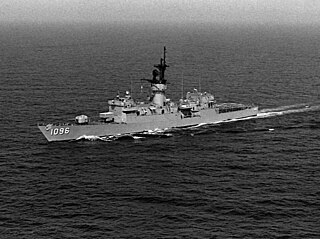
The third USS Austin (LPD-4) was the lead ship of her class of amphibious transport dock ships in the United States Navy. Austin was named in honor of the city of Austin, Texas which in turn was named in honor of Stephen F. Austin, a Texian patriot during the Texas War for Independence and the first Secretary of State of the Republic of Texas.

USS America (CVA/CV-66) was one of three Kitty Hawk-class supercarriers built for the United States Navy in the 1960s. Commissioned in 1965, she spent most of her career in the Atlantic and Mediterranean, but did make three Pacific deployments serving in the Vietnam War. She also served in the Persian Gulf War's operations Desert Shield and Desert Storm.

USS Barney (DD-956/DDG-6) was a Charles F. Adams-class guided missile destroyer in the United States Navy. She was the third Navy ship named for Commodore Joshua Barney USN (1759–1818).

USS Vogelgesang (DD-862) was a Gearing-class destroyer in the United States Navy. She was named for Rear Admiral Carl Theodore Vogelgesang USN (1869–1927).

USS Arthur W. Radford (DD-968) was a Spruance-class destroyer in the United States Navy. She was named for Admiral Arthur W. Radford USN (1896–1973), the first naval officer to be Chairman of the Joint Chiefs of Staff.

USS Moosbrugger (DD-980) was a Spruance-class destroyer built for the United States Navy by the Ingalls Shipbuilding Division of Litton Industries at Pascagoula, Mississippi. Affectionately nicknamed the "Moose" by her crews, she was named in honor of Vice Admiral Frederick Moosbrugger who is best known for his service in World War II as a highly successful commander of destroyer squadrons.

USS Harry E. Yarnell (DLG/CG-17) was a Leahy-class guided missile cruiser of the United States Navy. Named in honor of Admiral Harry E. Yarnell (1875–1959), she was originally classified as a "destroyer leader" or frigate, in 1975 she was redesignated a cruiser in the Navy's ship reclassification. She was the second of the "double-end" Leahy-class guided missile frigates to join the fleet.

USS William V. Pratt (DLG-13/DDG-44) was a Farragut-class destroyer in the service of the United States Navy. She was commissioned in 1961 as DLG-13 and reclassified as a guided missile destroyer, designation DDG-44, in 1975. She was named to honor Admiral William Veazie Pratt, a President of the Naval War College and a Chief of Naval Operations.

The third USS Blakely (DE-1072/FF-1072) was a Knox-class destroyer escort in the United States Navy. She was reclassified as a frigate in 1975 along with her entire class. Her primary mission of ASW remained unchanged. She was named for Captain Johnston Blakeley and Charles Adams Blakely. She was primarily stationed out of Charleston, South Carolina.

USS Voge (FF-1047), a Garcia-class frigate of the United States Navy, was named after Rear Admiral Richard George Voge. It fulfilled a Protection of Shipping (POS) mission as anti-submarine warfare (ASW) combatants for amphibious expeditionary forces, underway replenishment groups and merchant convoys. It made notable contributions to submarine 'hold-down' tactics with sister ship Koelsch. A Soviet submarine collided with it in 1976.

USS Truett (FF-1095) was a Knox-class frigate named after Quincy Hightower Truett, who received the Navy Cross posthumously. The ship is now serving in the Royal Thai Navy as the HTMS Phutthayotfa Chulalok.

USS Basilone (DD/DDE-824) was a Gearing-class destroyer of the United States Navy, named for Gunnery Sergeant John Basilone (1916–1945), who was awarded the Medal of Honor for "extraordinary heroism and conspicuous gallantry in action...." in the defense of Henderson Field during the 1942 Guadalcanal campaign.

USS Vreeland (FF-1068) was a Knox-class frigate of the United States Navy. The ship was named for Rear Admiral Charles E. Vreeland (1852–1916).

USS Aylwin (FF-1081) was a United States Navy Knox-class frigate. She was the fourth vessel named for John Cushing Aylwin. Aylwin was laid down on 13 November 1969 at Westwego, La., by the Avondale Shipyard, Inc.; launched on 29 August 1970; sponsored by Mrs. Charles K. Duncan; and commissioned on 18 September 1971 at the Boston Naval Shipyard.

USS Ainsworth (DE/FF-1090) was a Knox-class frigate named for Vice Admiral Walden L. Ainsworth (1886–1960). Ainsworth (DE-1090) was laid down at Westwego, Louisiana, on 11 June 1971 by Avondale Shipyards, Inc.; launched on 15 April 1972; sponsored by Mrs. Katharine Gardner Ainsworth, the widow of Vice Admiral Ainsworth; and commissioned on 31 March 1973 at the Norfolk Naval Shipyard, Portsmouth, Virginia.

USS Valdez (FF-1096) is the forty-fifth Knox-class frigate and was built by Avondale Shipyard, Westwego, Louisiana, and originally designated as an ocean escort (DE-1096). Commissioned in the United States Navy from 1974 to 1991, she was the first U.S. Navy ship to be named for a Spanish-descended American war hero. In 1998, Valdez was leased to Taiwan and renamed Yi Yang (FF-939).

USS W. S. Sims (FF-1059) was a Knox-class frigate of the United States Navy named for William Sims. She was in commission from 1970 to 1991.

USS McCloy (FF-1038) was the second and final Bronstein-class frigate. Commissioned as a destroyer escort, McCloy was redesignated as frigate on 30 June 1975. Decommissioned on 14 December 1990, and stricken from the Navy list on 4 October 1991, McCloy was transferred to Mexico on 12 November 1993, where she was recommissioned as Nicolas Bravo. Named for Lt. Comdr. John C. McCloy, recipient of two Medals of Honor.

USS Waccamaw (AO-109) was a Cimarron-class replenishment oiler in the United States Navy. She was named after Waccamaw River. The original capacity was 146,000 barrels (23,200 m3).

USS Walworth County (LST-1164), previously USS LST-1164, was a United States Navy landing ship tank (LST) in commission from 1953 to 1971, and which then saw non-commissioned Military Sealift Command service as USNS Walworth County (T-LST-1164) from 1972 to 1973.




















